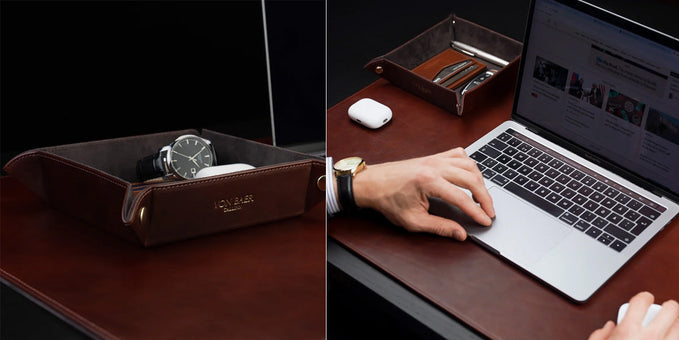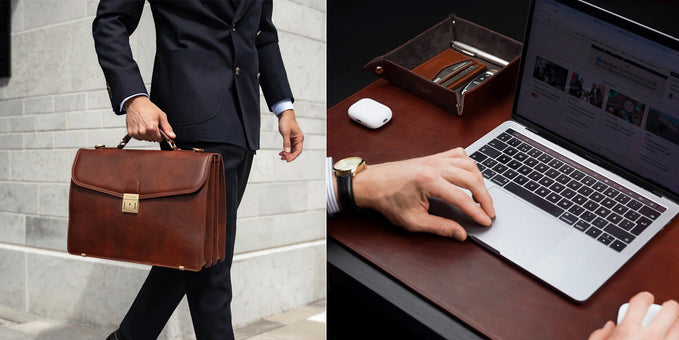Wet Molding Leather: Simple Techniques You Can Follow

Master the art of wet-forming leather, and you’ll be able to create your own leather purses, handbags, and accessories from a single piece of hide.
It is a technique used by leathermakers for centuries.
In this complete guide to wet-forming leather, we’ll explain everything you need to know about shaping leather like a pro.
What is Wet Forming Leather?

Wet forming is a process leathermakers use to mold a piece of leather hide into a desired shape.
There are two primary ways to do this.
The first is by hand, the second by using a two-piece mold.
Both wet forming techniques require a certain amount of elbow grease, and you’ll need the right tools to create any shape in leather, but once you master this traditional leather forming skill, you can create almost any leather item.
Choosing the Best Leather for Wet Forming

The vegetable tanned leather used to make Von Baer bags.
The best type of leather for wet forming is vegetable-tanned leather with a thickness of around 5oz.
Anything thicker than this is difficult to form around the mold, and thinner leather may split if worked too hard.
Ultimately, the leather should be stiff enough to maintain its new shape yet supple enough to create your desired object.
Wet Molding Techniques
As we mentioned previously, there are two ways to wet-form leather. Here we provide an overview of both:
Wet Molding by Hand

- Wet molding leather by hand is an art form that can take many years to master.
- To start, you need to cut out a piece of leather, making sure you have enough excess to create the shape you want to achieve.
- Next, soak the leather in water until it is completely saturated. This process can take anywhere from 30 minutes to an hour, depending on the size of the piece.
- Now that your leather is flexible, you can place it onto your mold and use your hands (or a bone folder) to work it into shape.
- Finally, use small binder clips to secure the leather to the mold and allow it to dry.
- Once completely dry, you can remove the leather from the mold in its new shape.
Wet Molding with a Mold
- Wet forming leather with a mold is a similar process to forming it by hand, but in this instance, you use a second mold to secure and shape the leather.
- After soaking your piece of hide, you lay it over the shaping mold before clamping it down with the securing mold.
- You then leave this to dry for 24 hours before removing the leather from the molds and trimming any excess materials.
Challenges You May Face When Wet Forming Leather

Wet forming leather may sound like a straightforward process, but it can take many years to get it right, and you should expect some obstacles along the way.
Here are a few challenges you may face when wet forming leather for the first time:
- Leather drying out too soon: Leather dries surprisingly fast, particularly in warm temperatures, and if your hide dries out before you have formed its new shape, it will not hold. Keep a wet sponge close to hand and saturate your leather as often as needed to keep it pliable.
- Marks and blemishes: Leather is a sensitive fabric, and you can easily cause surface blemishes during the wet forming process. Avoid using tools with sharp edges, and use the back of a spoon to smooth any marked areas before allowing it to dry.
- Rippling: Wet forming leather along a straight line is relatively easy but less so when curves are involved. To prevent rippling around the edges when applying leather to the mold, cut the leather close to the mold with an excess of at least ¼ inch.
It takes time and dedication to master the art of wet molding leather, but it is an admirable skill to hold.
Whether you decide to mold by hand or use the more modern approach, you will likely experience a lot of obstacles along the way, but with this craft, patience and persistence pay off.
Try wet molding leather today, and you’ll soon be able to create custom leather goods at home.
Conclusion
We hope you enjoyed our article on wet molding leather.
If you have any questions or comments, contact us at info@vonbaer.com, or leave them in the comments.
Want to read more? Check out our Leather pages.
Related articles:
- How to reform a leather bag
- How to maintain leather bags
- Wet leather
- How to clean leather bag
- How to restore faded leather bag
- How to stretch leather
- How to shrink leather
- How to soften leather
- How to wash leather
- Bleach On Leather
- How To Fix Scuffed Leather
- How To Rehydrate Leather
- How To Stiffen Leather
- How To Restore Leather
- How To Dye Leather
- How To Get Wrinkles Out Of Leather
- How To Clean Leather
- How To Clean a Leather Purse
- Leather

Author: Albert Varkki
Albert Varkki is the co-founder of Von Baer. He understands leather products as a consumer, supplier, and a manufacturer, helping you with the inside knowledge you need, to choose the perfect leather product for you.
We strive for the highest editorial standards, and to only publish accurate information on our website.
Leave a Comment
Your email address will not be published.







